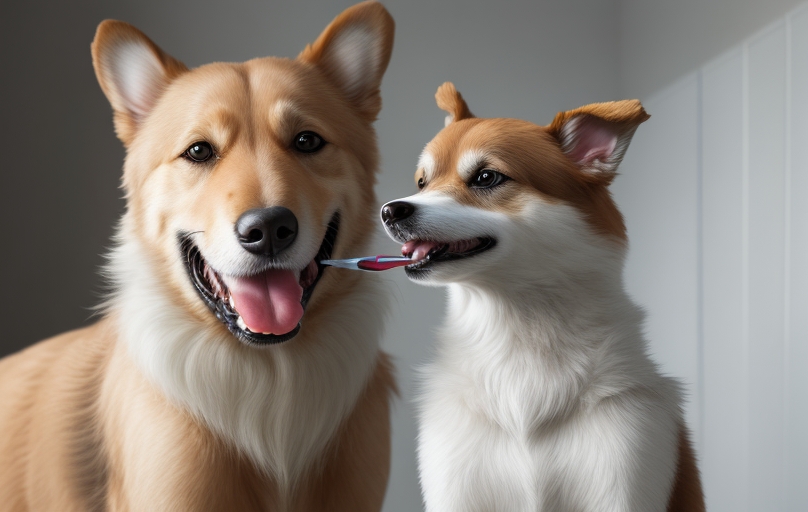If you are looking for How to Brush Your Dog’s Teeth? So, this guide serves you in a good way. Brushing your dog’s teeth is essential to their overall health and well-being. Just like humans, dogs are susceptible to dental problems, including gum disease and tooth decay, if their teeth are not adequately cared for. In this article, we will provide you with a step-by-step guide on how to brush your dog’s teeth effectively, along with scientific research to emphasize the importance of this practice for your furry friend’s oral health.
Scientific Research on Canine Dental Health
Prevalence of Periodontal Disease in Dogs and Cats Presented for Dental Care at a University Dental Service.” This study, published in the Journal of Veterinary Dentistry, highlighted the high prevalence of dental issues in pets. It underscores the need for regular dental care, including brushing.
“Association between Canine Periodontal Disease and Systemic Inflammatory, Oxidative and Nitrosative Stress Markers.” Research published in the journal Veterinary Immunology and Immunopathology found a correlation between periodontal disease in dogs and systemic health markers. This study emphasizes the importance of maintaining oral health in dogs to prevent potential systemic health problems.
“Effects of a Dental Health Chew on Clinical Parameters and the Concentration of Nitric Oxide in the Saliva of Dogs with Periodontal Disease.” This research, published in the Journal of Veterinary Dentistry, explores the efficacy of dental chews in maintaining oral health in dogs. While dental chews can be a useful addition to oral care, brushing remains a vital component.
Why Brushing Your Dog’s Teeth is Important

Oral hygiene is a crucial aspect of your dog’s overall health. Dental issues can lead to pain, discomfort, and even more severe health problems if left unattended. Regular tooth brushing helps prevent:
Gum Disease:
Gingivitis and periodontal disease are common dental issues in dogs. These conditions can lead to pain, tooth loss, and systemic health problems.
Bad Breath:
If your dog has bad breath, it could be a sign of dental issues. Regular brushing can help combat this problem.
Tooth Decay:
Just like humans, dogs can experience cavities and tooth decay if their teeth are not cared for.
Systemic Health Problems:
Emerging research suggests a link between periodontal disease in dogs and other health issues, such as heart disease and kidney problems.
How to Brush Your Dog’s Teeth

Now, let’s go through a step-by-step guide on how to brush your dog’s teeth:
Step 1: Gather Your Supplies
Before you begin, ensure you have all the necessary supplies ready:
- Dog-friendly toothbrush: You can use a special dog toothbrush or a soft-bristle human toothbrush.
- Dog toothpaste: Never use human toothpaste, as it may contain ingredients harmful to dogs.
- Treats or rewards: To make the experience more pleasant for your dog.
Step 2: Get Your Dog Comfortable
Help your dog get accustomed to the brushing process by first letting them sniff and lick the toothbrush and toothpaste. This allows them to familiarize themselves with the new items.
Step 3: Introduce Toothpaste

Apply a small amount of dog toothpaste to the toothbrush. Dog toothpaste is available in various flavors that dogs typically enjoy. Gently lift your dog’s lips and brush a few teeth with the paste to get them used to the taste.
Step 4: Brushing the Teeth
Now, gently hold your dog’s mouth closed and lift their lips to expose the teeth. Brush in a circular motion, focusing on the gum line. Start with a few teeth during the first session, gradually increasing the number of teeth you brush. Be patient and offer treats as a reward for cooperation.
Step 5: Frequency
Ideally, it would be best if you brushed your dog’s teeth 2-3 times a week. This routine will help prevent dental issues and maintain your dog’s oral health.
Conclusion:
How to Brush Your Dog’s Teeth? Brushing your dog’s teeth is a crucial practice for maintaining their oral health and overall well-being. By following the steps outlined in this guide and understanding the scientific research supporting this practice, you can help ensure that your furry friend enjoys a healthy and happy life with a bright smile.
Read Also: How to Brush Your Dog’s Teeth
Frequently Asked Questions
How often should I brush my dog’s teeth?
Brushing your dog’s teeth 2-3 times a week is ideal for the best results.
Can I use human toothpaste for my dog?
No, human toothpaste is not safe for dogs. Use toothpaste specifically designed for canines.
What if my dog resists tooth brushing?
Be patient and consistent. Gradually introduce them to the process and use positive reinforcement.
Are dental chews an excellent alternative to brushing?
While dental chews can help, they should not replace regular brushing for optimal oral health.
When should I start brushing my dog’s teeth?
Start as early as possible to acclimate your dog to the process and maintain their dental health.

1 thought on “How to Brush Your Dog’s Teeth: 5 Easy Steps”